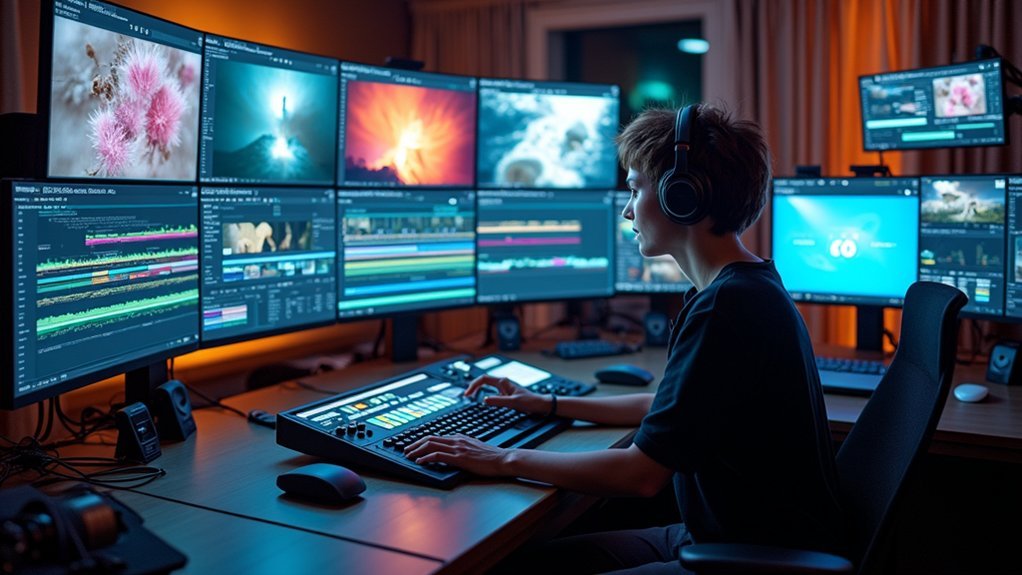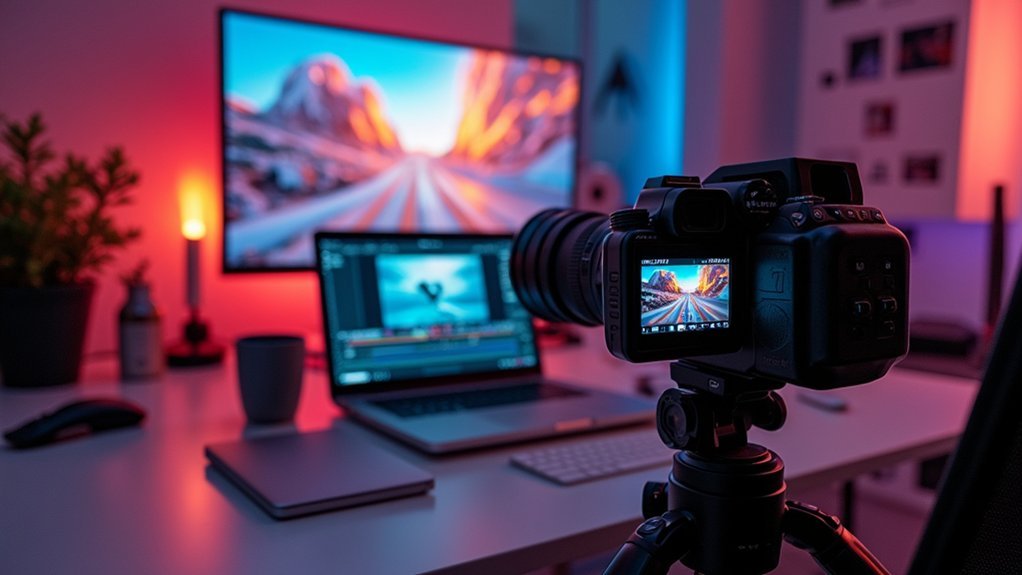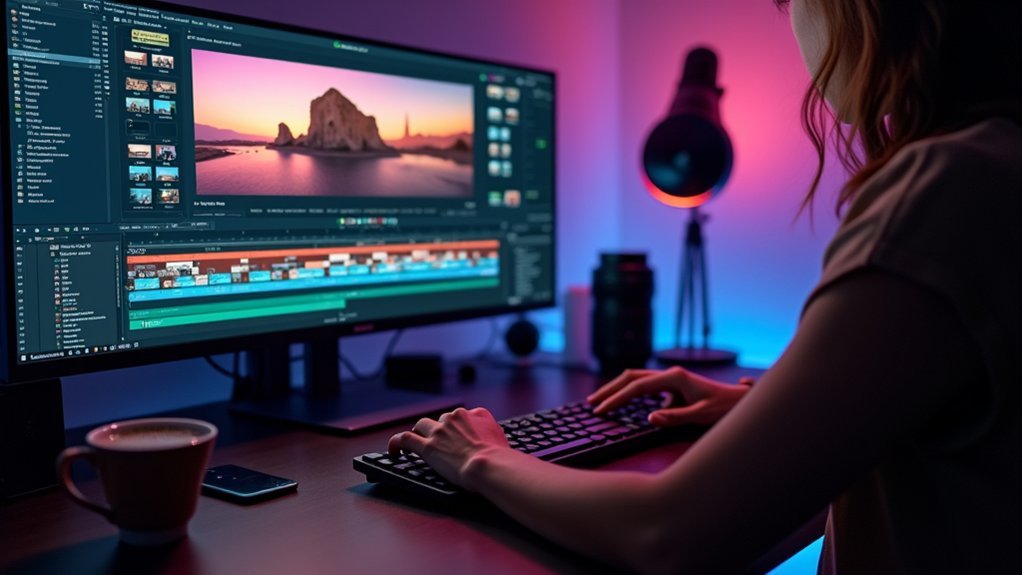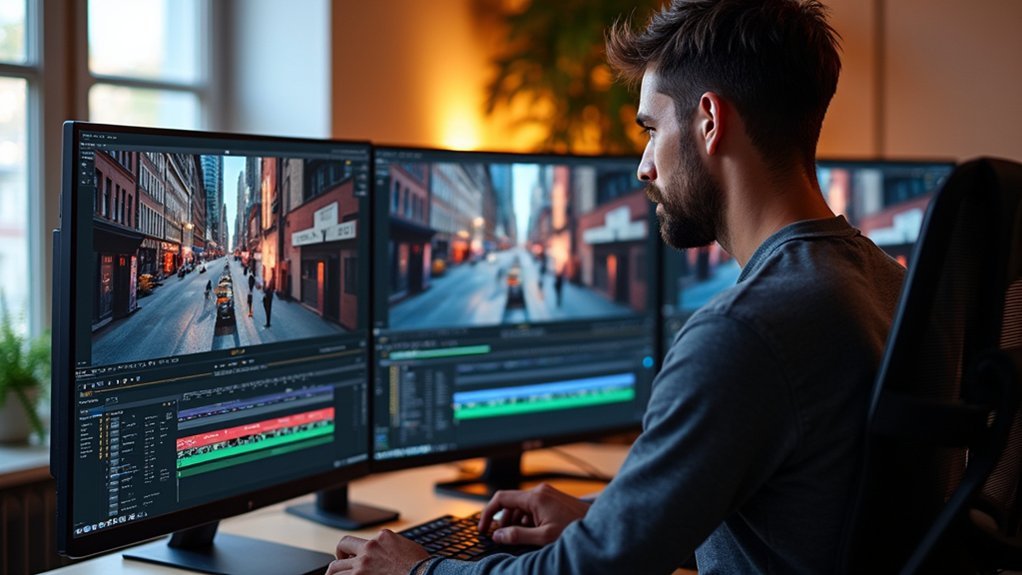You’ll achieve smooth 360-video editing by using specialized software like Adobe Premiere Pro with the GoPro Reframe FX Plugin, which handles spherical content effectively. Set your project to match footage resolution and frame rates while using high-quality codecs for visual fidelity. Master keyframing with minimal anchor points and Bezier curves for fluid motion, avoiding jerky shifts that break viewer immersion. Configure output settings for your target platform’s specific requirements. These foundational techniques reveal professional-quality results.
Understanding Common 360-Degree Footage Challenges

When you’re working with 360-degree footage, you’ll quickly discover that traditional editing approaches don’t translate seamlessly to this immersive medium.
You’ll face massive file sizes that can overwhelm your system’s processing power, creating frustrating delays throughout your workflow. Understanding spatial orientation becomes essential since you’re now working within a spherical environment rather than a flat frame.
Massive 360-degree files strain processing power while spherical environments demand completely different spatial thinking than traditional flat video editing.
Color grading and stabilization require specialized techniques because you’re dealing with omnidirectional content.
Let’s say you want smooth shifts – any abrupt cuts will jar viewers and break their immersion. You’ll also need to master different export settings and projection types to optimize your end result for various platforms.
These challenges demand new skills and tools, but recognizing them upfront helps you prepare for a smoother editing experience.
Selecting the Right Editing Tools and Software
Since traditional editing software wasn’t designed for spherical content, you’ll need specialized tools that can handle 360-degree footage’s unique demands. Adobe Premiere Pro with the GoPro Reframe FX Plugin stands out as an excellent choice for managing immersive content effectively.
You’ll want editing software that supports multiple camera formats. The GoPro Reframe FX Plugin works with various brands, giving you flexibility across different projects. Look for streamlined features like overlay functions that help with navigation and framing adjustments.
Keyframing capabilities are essential—they’ll let you create dynamic movements within the 360-degree space while maintaining smooth changes. Advanced controls like motion blur can enhance fast-moving sequences, but use them carefully to preserve clarity throughout your footage.
Installing and Setting Up the GoPro Reframe FX Plugin

You’ll need to download the GoPro Reframe FX Plugin from the official source, making sure you’re getting the version that matches your operating system.
Once you’ve got the file, follow the installation instructions to properly integrate it with Adobe Premiere Pro.
After installation’s complete, you can create your new sequence and access the plugin through Premiere’s effects panel to start working with your 360-degree footage.
Download and Installation Process
Getting the GoPro Reframe FX Plugin up and running requires a straightforward download and installation process that’ll have you editing 360-degree footage in minutes.
Start by locating the plugin through a web search or following the provided link specific to your operating system. You’ll need to download the correct version that matches your system requirements.
Once you’ve downloaded the plugin, follow the installation instructions carefully to guarantee seamless integration with Adobe Premiere. The setup process is designed to automatically configure the plugin with your editing software.
After installation, create a new sequence in Premiere with your preferred settings, such as 1080p resolution at 25 fps.
Import your 360-degree footage into the timeline, then access the GoPro FX Reframe plugin from the effects panel to begin editing.
Premiere Integration Setup
Once your GoPro Reframe FX Plugin downloads successfully, the integration process with Adobe Premiere requires specific configuration steps to guarantee peak performance.
You’ll need to follow the installation instructions precisely to confirm the plugin communicates effectively with Premiere’s interface. After completing installation, launch Adobe Premiere and create a new sequence tailored to your project needs – consider settings like 1080p resolution at 25 fps for ideal workflow efficiency.
Import your 360-degree footage directly into the timeline, then access the effects panel to locate your newly installed GoPro FX Reframe plugin.
You’ll want to explore the plugin’s core features, including various output projection types and keyframing capabilities, which enable precise manipulation of your 360-degree content throughout the editing process.
Configuring Project Settings for Optimal Output
You’ll need to configure your project settings correctly to guarantee your 360-video renders at ideal quality.
Start by setting your sequence resolution to match your footage – typically 1080p or higher – to maintain crisp, detailed output.
Next, you’ll want to enhance your frame rate by selecting either 25 fps or 30 fps to achieve smooth motion and eliminate choppy playback.
Sequence Resolution Setup
Before you plunge into importing your 360-degree footage, establishing the correct sequence settings forms the foundation of your entire editing workflow.
You’ll need to set your resolution to 3840×1920 for standard 360 footage, which preserves peak quality and detail throughout your project. Make certain your frame rate matches your original footage—typically 30 fps or 60 fps—to maintain smooth playback and visual consistency.
Choose your aspect ratio carefully: 16:9 works best for YouTube, while 9:16 suits Instagram content. This prevents cropping issues and maintains the immersive 360-degree experience.
Configure your sequence with high-quality codecs like ProRes or DNxHR to enhance visual fidelity and guarantee smoother editing performance.
Finally, align your settings with your desired output projection type to eliminate black bars and preserve your audience’s intended viewing experience.
Frame Rate Optimization
Frame rate configuration directly impacts your 360-degree video’s visual quality and viewer experience.
You’ll want to match your project settings to your original footage’s frame rate, typically 30 fps or 60 fps, ensuring smoother playback and preventing motion artifacts during editing.
Set your project resolution to at least 1080p or higher to maintain detail and avoid pixelation.
Consistency is key—stick with one frame rate throughout your entire editing process, whether it’s 24, 30, or 60 fps, to prevent syncing issues and achieve a polished result.
When rendering, export at the same frame rate as your source footage to preserve visual fluidity.
Additionally, adjust your editing software’s playback settings to match your output frame rate for smoother previews and reduced lag.
Mastering Plugin Features for Framing and Navigation

While 360-video capture opens creative possibilities, the GoPro FX Reframe plugin transforms raw spherical footage into compelling traditional content through precise framing control. You’ll navigate your spherical footage efficiently using the overlay feature, which provides visual references for accurate positioning. The plugin’s intuitive controls let you adjust zoom, roll axis, and lens curvature to guide your viewer’s perspective seamlessly.
| Feature | Function | Best Practice |
|---|---|---|
| Output Projection | Select 16:9, 4K formats | Match platform requirements |
| Keyframing | Create dynamic movements | Use minimal keyframes |
| Motion Blur | Enhance fast shots | Apply cautiously |
You can create smooth shifts by strategically placing keyframes throughout your timeline. For fast-moving sequences, motion blur adds realism, but use it sparingly to maintain clarity and avoid viewer disorientation.
Implementing Keyframing Techniques for Dynamic Movement
Strategic keyframe placement transforms static 360-degree footage into cinematic experiences that guide viewers through your spherical world with purpose.
You’ll define specific time points for framing adjustments, creating dynamic movement that flows naturally throughout your clip. Keep keyframes minimal while ensuring framing changes remain subtle and gradual—this prevents jarring shifts that’ll break viewer immersion.
Utilize continuous bezier curves for your keyframe movements to enhance fluidity and eliminate abrupt perspective changes.
You should regularly preview your rendered video to catch any bouncing or jarring movements caused by improperly positioned keyframes. If you’re encountering smoothness issues, don’t hesitate to adjust keyframes back to linear interpolation—this simplifies movement and creates a more stable viewing experience that keeps audiences engaged.
Smoothing Transitions With Bezier Curve Adjustments
Although keyframes establish the foundation of dynamic movement, Bezier curve adjustments determine whether your shifts feel cinematic or mechanical. You’ll want to apply continuous Bezier curves to create fluid motion between framing positions. Keep your keyframe count minimal while achieving desired movements—this reduces abrupt changes and delivers a polished result.
| Shift Type | Visual Result |
|---|---|
| Linear Keyframes | Sharp, mechanical movements |
| Bezier Curves | Smooth, natural flow |
| Too Many Keyframes | Jerky, unstable motion |
| Optimized Keyframes | Clean, professional shifts |
After applying adjustments, render your video to preview shift smoothness. If movements appear bouncy or unnatural, switch back to linear keyframes for stability. Bezier curves enhance visual flow while preserving framing integrity throughout dynamic scenes, ensuring your 360-video maintains professional quality.
Utilizing Advanced Controls for Enhanced Visual Quality
Beyond basic keyframing techniques, you’ll discover that advanced control settings can dramatically elevate your 360-video’s visual impact. Motion blur becomes your ally for capturing fast movements with cinematic quality, but you’ll want to apply it judiciously—overdoing it will sacrifice essential detail and clarity.
The GoPro Reframe FX Plugin’s lens curvature adjustments transform flat-looking footage into immersive experiences with enhanced depth perception. You’ll notice how proper curvature settings make viewers feel genuinely present in your scene.
Don’t overlook projection type modifications either. Switching to 9:16 creates Instagram-ready vertical sequences without distracting black bars, maximizing engagement on mobile platforms.
Throughout these adjustments, you must maintain tracking and framing integrity to preserve the seamless, immersive quality that makes 360-degree footage compelling.
Optimizing Output for Different Platform Formats
When you’re ready to share your 360-video across multiple platforms, you’ll need to tailor your output settings to match each platform’s specific requirements and audience viewing habits. You should switch your projection type to 9:16 for vertical videos, preventing unsightly black bars on platforms like Instagram.
| Platform | Recommended Resolution | Aspect Ratio |
|---|---|---|
| YouTube | 4K (3840×2160) | 16:9 |
| 1080p (1080×1920) | 9:16 | |
| 1080p (1920×1080) | 16:9 |
Use the GoPro FX Reframe plugin to select appropriate output resolutions easily. Apply keyframing for smooth shifts that maintain platform-specific framing. Confirm your tracking and framing integrity remains intact when changing aspect ratios, keeping important visual elements in focus. Always preview your rendered videos in their final format to verify shifts function smoothly across different devices.
Frequently Asked Questions
How to Make Editing Video Smooth?
You’ll achieve smooth video editing by using strategic keyframes with continuous bezier interpolation, minimizing abrupt shifts, previewing renders frequently, and applying motion blur judiciously to enhance visual quality without sacrificing clarity.
What Is the 321 Rule in Video Editing?
You’ll protect your video projects by keeping three copies of your data on two different storage types, with one copy stored off-site to prevent loss from hardware failures or disasters.
What’s the Best Way to Edit Insta360 Videos?
Use Adobe Premiere Pro with GoPro Reframe FX Plugin for smooth 360-degree editing. You’ll frame shots with the overlay feature, apply minimal keyframes with bezier curves, and adjust output projection for your platform.
What Is the Best Format for 360 Video?
You’ll want equirectangular projection at 4K resolution minimum. Use MP4 or MOV formats with 30+ fps for smooth playback. Don’t forget to include proper 360 metadata so platforms recognize your video correctly.





Leave a Reply